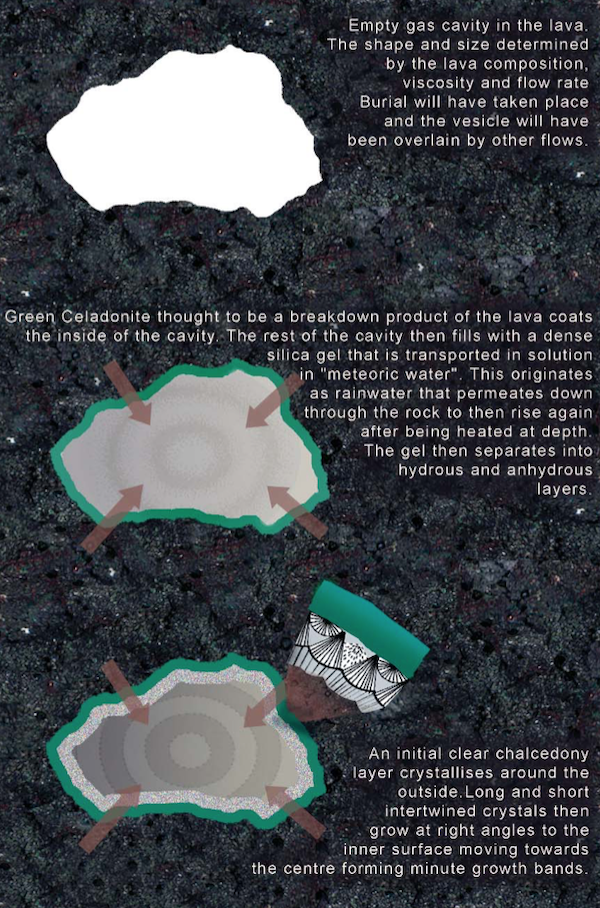
 |
| Agate Formation |
In his book “Agates” 1989 Harry Macpherson states: “the formation of lava flows and the formation of agates are not contemporaneous or even connected events.” Molten lava contains gases held under pressure before being erupted on to the Earth’s surface. At the time of eruption, as the pressure is reduced, the space this gas occupies increases and gas bubbles form. The gases mainly involved include carbon dioxide, water vapour, sulphur dioxide, chlorine and even hydrogen sulphide. Many of these bubbles burst to the surface and the gas is vented but as the outer lava layer cools some of the gas bubbles are trapped. |
 |
| Rich amygdaloidal lava with agate infill from Usan, near Montrose, Tayside |
This can be considered the initial part of the formation process. These bubbles are called vesicles when the lava cools and later when filled with celadonite or agate become amygdales. Amygdaloidal (from the Latin “amygdula”, an almond) lava is so called because the original vesicular material contains almond-shaped cavities. As well as almond shaped these cavities can be totally misshapen, probably due to the flow effect within the flowing liquid lava, round, oval, almost flat or even bun-shaped. The viscosity of the fluid rock through which the bubbles are ascending may determine this shape. Heddle (1901) described amygdale shapes as round, rod-shaped, pear or balloon-shaped, axe-shaped and even wine-bottle shaped. The cavities subsequently become filled with agate forming materials. Agates can form in fissures within rock called veins, or as long filaments similar to but more numerous than veins, called stringers. An example of this type of agate can be found at Burn Anne near Galston, Ayrshire. Agates can also form within sedimentary rocks as nodules that are the result of the replacement of a former mineral or some organic material such as wood or coral. |
 |
 |
| Amygdale in lava from Ethiebeaton Quarry, near Dundee | Loose amygdale with red coating from Barras Quarry, near Montrose |
 |
| Agatised coral (Lithostrotion sp. Carboniferous age from the Galdrons, Mull of Kintyre. |
Agates do not appear to form in the final cooling phase of volcanic rock. It is only after complete cooling and burial of the flows to depths of at least 100 – 200 metres that they form (Macpherson 1989) The description in the previous few paragraphs here is certainly a part of the more widely accepted initial theory of agate formation. From now on it becomes much more complex and scientifically controversial. There does not appear to be one unifying theory from this point. It can however be said that in general they form from an amorphous deposit of silica-rich material which fills the cavity. It is thought that silica-rich solutions enter from outside and form gels inside or that solutions form outside and then move into the cavity. These solutions then deposit silica from the outer part to the inner part of the cavity over an indeterminate period of time. Some recent work suggests that agates do not grow linearly but are subject to “stops and starts” Some researchers suggest that some of the oldest agates in the world have grown for the first 60 million years then stop for 210 million years and then grow again for the next 80 million years. The initial growth rate in these materials has been shown to be approximately 1 nanometre per million years (Moxon 2009). Others suggest that agates form in geological systems and appear to form in under 30,000 years (Donald Kasper, 2014). This researcher also suggests that agates form in Super Critical States with temperatures in the rage 374 – 575 degrees Celsius and pressures as high as 2kbar. |
| < Home |
The Uncertainties in Agate Formation Given the structural and compositional similarities between agates from all parts of the world it has been hypothesized that agate formation occurs independently of any outside influences and that the banding as well as the colouring is largely chemically controlled. In other words, the variation in the texture and composition must result from the closed internal dynamics of the growth itself rather than any variable conditions outside the agate (Wang et al.,1995). The crystallisation behaviour that controls this compositionally simple mineral system is believed to be very complex.
Source of the Silica
|
Deposition
|
 |
 |
There are a number of other theories that attempt to explain deposition using percolating crystallization from fluids in hydrothermal systems. Each theory appears to explain agate deposition adequately but so far, unfortunately, none of them have resulted in agate-like patterns in laboratory tests. Conceivably, a better understanding of the timescale of formation is needed to construct a truly workable model of agate deposition. |
| < Home |
Temperature and Pressure of Formation
|
Conclusion An attempt has been made here to draw together the current thinking on the formation of agates and present it in as simplified a way as possible without losing too much of the detail. It is clear that there is no single accepted detailed explanation of how agates form. As mentioned above no researcher has yet managed to start with basic ingredients and create a whole agate nodule, exhibiting all the familiar agate characteristics, at the end of the experiment. Perhaps agates form under a variety of differing conditions and processes and therefore there can be no one single unifying theory of formation? This certainly appears to be the case with the zeolite group of minerals, which also form within cavities in volcanic rock.
...and finally..... |
 |
| Possible hydrothermal environment for agate formation? |
| < Home |